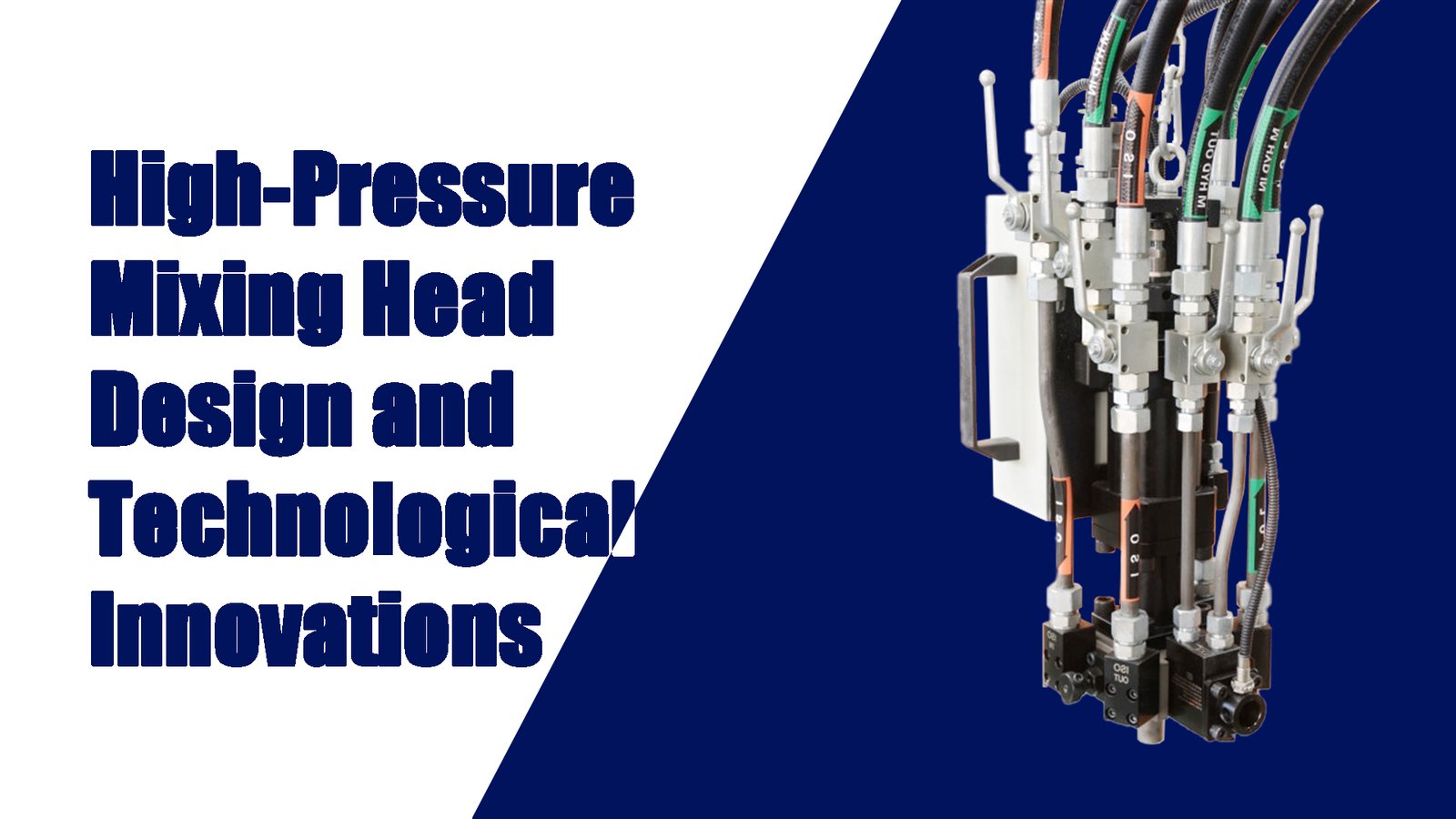The high-pressure mixing head is a crucial component in polyurethane foaming machines. It is responsible for rapidly and uniformly mixing the two chemical components, A (isocyanate) and B (polyol), under high pressure to ensure a smooth foaming process. Since the performance of the mixing head directly influences the quality, properties, and stability of the foam, its design, materials, and technological innovations play a significant role in improving foam production. With continuous technological advancements, modern high-pressure mixing heads have greatly enhanced material selection, self-cleaning functions, mixing efficiency, and application versatility, meeting the demands of various industries and applications.
Materials and Durability of High-Pressure Mixing Heads
High-pressure mixing heads are subjected to extreme conditions during operation, including high pressure, temperature, and exposure to highly corrosive chemicals. Therefore, selecting the right materials and surface treatment techniques is essential to extend the life and maintain the stability of the mixing head.
Stainless Steel and Alloys
Stainless steel is a common material used for high-pressure mixing heads due to its excellent corrosion resistance, high-temperature resistance, and strength. It can withstand the harsh chemical environment, especially when exposed to aggressive chemicals like isocyanates. Stainless steel is highly resistant to corrosion, ensuring the long-term stability of the equipment. For applications requiring even greater durability, alloys such as titanium and chromium alloys are used. These materials offer superior resistance to corrosion, fatigue, and wear, making them ideal for high-performance and demanding applications.
Ceramic and Hard-Coated Materials
In high-end applications, ceramic materials and hard coatings (such as titanium nitride TiN) are applied to the surface of mixing heads to enhance their durability. These materials offer exceptional wear resistance, high-temperature tolerance, and chemical stability. Ceramic components, for instance, are known for their low friction coefficient and chemical inertness, making them ideal for aggressive environments. They significantly extend the life of mixing heads and minimize wear-induced performance degradation.
Design Features of High-Pressure Mixing Heads
The design of a high-pressure mixing head has a direct impact on mixing efficiency, foam quality, and production performance. Modern mixing heads are designed not only to optimize performance but also to be easier to clean, maintain, and operate.
Self-Cleaning Functionality
In traditional foam production processes, the transition between different foam formulations or blowing agents requires manual cleaning of the mixing head. This leads to production downtime and additional labor costs. To enhance efficiency, modern high-pressure mixing heads are equipped with self-cleaning features. The self-cleaning function automatically purges residual materials after each production cycle, reducing the need for manual cleaning and ensuring seamless transitions between production runs. This feature significantly reduces cross-contamination and improves flexibility, allowing manufacturers to quickly change formulations without production interruptions.
Efficient Mixing Structures
The effectiveness of foam production is highly dependent on the mixing process. To enhance mixing efficiency and uniformity, modern high-pressure mixing heads incorporate various innovative design features, such as multiple nozzles, spiral flow guides, and adjustable flow channels. By optimizing the nozzle size and flow angle, these designs ensure rapid and thorough mixing of the A and B components in a very short time frame, preventing uneven foam quality. In applications that require high-density, uniform, and stable foam, such as high-hardness foam production, an efficient mixing structure plays a crucial role in achieving superior product quality and reducing defects.
Flow and Pressure Regulation
The flow and pressure within a mixing head directly influence the density, hardness, and uniformity of the foam. Modern mixing heads are designed with precise flow and pressure control mechanisms that allow for adjustments based on the specific production needs. In high-pressure foam applications, controlling the flow rate and pressure is essential to achieving consistent foam characteristics. By optimizing these parameters, manufacturers can produce foam with consistent density, improved stability, and minimized wastage, leading to higher-quality products and improved efficiency.
3. Mixing Uniformity and Its Impact on Foam Quality
The uniformity of the mixing process is one of the most important factors in determining foam quality. High-pressure mixing heads directly influence the uniformity of the foam, which impacts the foam’s density, stability, and mechanical properties. Uniform mixing ensures that the chemical reaction between the A and B components occurs evenly, leading to consistent foam performance across the entire production batch.
Uniformity and Foam Density
Foam density directly affects the product’s mechanical properties, durability, and appearance. During the high-pressure foaming process, it is essential for the A and B components to be thoroughly mixed to ensure even foam density. Uneven mixing can result in areas of foam that are either too dense or too sparse, leading to defects such as bubbles or weak spots in the foam structure. A well-designed mixing head ensures that the foam density remains uniform across the entire batch, improving product consistency and overall quality. This is especially important in industries like automotive seating, where foam must meet specific density and durability requirements.
Stability of Foam
The stability of the foam is crucial for ensuring the quality of the final product. During the foaming process, the mixing head must not only provide efficient mixing but also control the expansion and contraction of the foam. Poor foam stability can result in over-expansion or shrinkage, leading to defects in the final product. High-pressure mixing heads regulate the shear strength and flow rate during the mixing process, ensuring that the foam’s expansion behavior is controlled and that the foam maintains its structural integrity throughout the production process.
Differences in Mixing Heads for Spraying vs. Foaming Applications
High-pressure mixing heads are designed to meet the specific needs of different applications. The requirements for spraying and foaming applications vary, and the mixing head must be tailored to ensure the best results.
Spraying Applications
In spraying applications, such as spray foam insulation or coating, the foam typically requires lower density and higher fluidity to cover large surface areas quickly. The mixing head used for spraying applications is designed for high shear and fluidity. By employing fine nozzles and high flow rates, these mixing heads are capable of producing a foam that can be sprayed onto surfaces quickly and evenly. The foam must have excellent flow characteristics to prevent splattering and to ensure smooth, even coverage. The spraying head design allows for rapid mixing and immediate foaming, resulting in a thin, uniform foam layer that cures quickly and adheres well to the surface.
Foaming Applications
In foaming applications, such as in the production of molded parts (automotive seats, insulation panels, etc.), the foam typically requires higher density, higher strength, and more precise control of foam characteristics. In these applications, mixing heads need to maintain precise control over the mix ratio, flow rate, and pressure to ensure that the foam sets properly and has the desired mechanical properties. The foaming mixing head typically features larger nozzles and more complex flow paths to ensure that the foam is mixed thoroughly before being injected into molds. These mixing heads allow for greater customization of foam density, hardness, and stability, ensuring that the foam meets the specific requirements of the final product.
Impact of Mixing Head Design on Foam Quality
Whether in spraying or foaming applications, the design of the mixing head directly impacts the final quality of the foam. In spraying applications, the focus is on fluidity and even distribution, while in foaming applications, the priority is on achieving consistent density and stability. The design of the mixing head must match the intended application to ensure that the foam meets both performance and aesthetic requirements. By adjusting the design of the mixing head, manufacturers can optimize foam characteristics and improve production efficiency.
The high-pressure mixing head plays a critical role in polyurethane foam production. Its design, materials, and technological innovations directly impact the mixing quality, foam density, stability, and final product performance. With advancements such as self-cleaning functions, efficient mixing structures, and precise flow and pressure regulation, modern high-pressure mixing heads are designed to meet the increasing demands of various industries. These innovations help enhance foam quality, reduce production costs, and increase overall production efficiency. As technology continues to evolve, the future of high-pressure mixing heads looks promising, offering even more efficient, eco-friendly, and sustainable solutions for the polyurethane foaming industry.




































